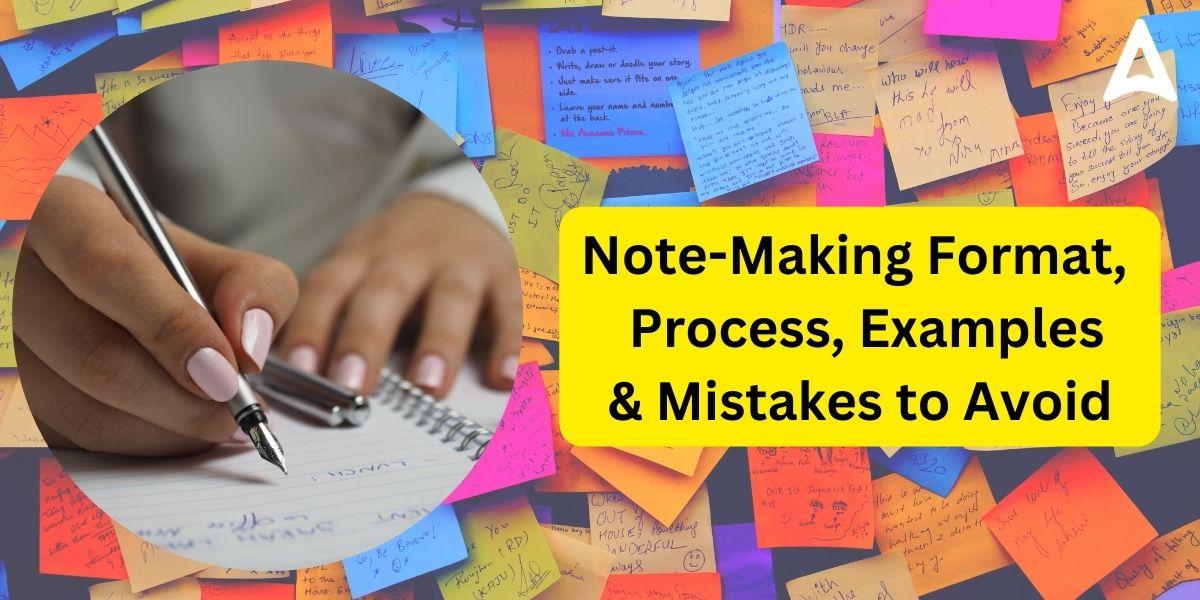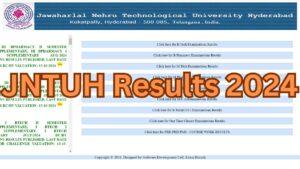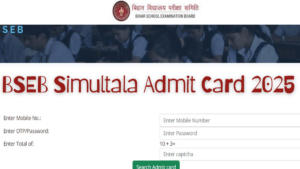Table of Contents
Note making is a crucial academic skill that involves summarizing and organizing information efficiently. It helps in retaining key points, improving comprehension, and preparing for exams or assignments. By converting lengthy material into concise and structured notes, students can focus on essential ideas and easily recall them later. Effective note-making includes identifying main themes, using bullet points, diagrams, and abbreviations to enhance clarity. It fosters critical thinking, active learning, and saves time during revision. Whether for lectures, readings, or personal research, mastering note-making enhances productivity and is essential for academic success.
Note Making
Note Making Format is a way of writing any complex or difficult structure of information in an organized, systematic and effective manner. Under this writing format, through points, through ideas, how to write concepts with explanation has been explained. Under this type of writing, presentations and reading material in a concise form, and writing knowledge in a modified form can be included. Formats typically include titles, subheadings, bullet points, abbreviation symbols, and visuals.
Note Making Format- example, the presentation of diagrams, and mind maps, helps to summarize any complex or difficult-to-write information systematically. The basic purpose of note-taking is to facilitate active writing and improve related understanding while maintaining the importance of the information.
What is the Main Purpose of Note Making?
The basic purpose of note making is to make it convenient to remember and understand any information. Apart from this, there are many purposes of note making which we have told you below-
- Presenting any explanation, presentation, or text material in a concise form through main points, ideas, and concepts
- Writing any information in an organized, structured, and easily accessible format
- Simplifying complex information for anyone to remember
- To serve as a reference for future study and revision
- Helping to identify and focus on the most important information.
- Helping to facilitate active reading and engagement with the course material being presented
- Identifying relationships between different types of concepts and ideas
- Creating competent articles for effective communication and sharing of information with others.
- Identifying all those areas for which study and research are necessary.
- Basically to evaluate critical thinking and analytical skills
- To evaluate information from various sources and develop related analysis skills
Read Notice Writing, Class 12, 10, Format, Topics with Examples
Essential Components of a Good Note Making Format
The following are the essential components for a good Note Making Format-
1. Clear and concise title: A concise and clear title helps in providing an overview of any text.
2. Use of Bullet Points: Bullet points can be used to summarize and highlight any key information.
3. Use of Abbreviations and Symbols: While running symbolically in short form, it can work to create space in the brain from time to time.
4. Construction of Diagrams and Flowcharts: Diagrams and flow charts, mind maps, etc. all help in clarifying detailed information and improving understanding.
5. Relevant Examples: With the help of relevant examples, it becomes easy to clarify any concept.
6. Summary and Conclusion: The summary of any article is the basic link to the brief overview of the entire article.
7. Personal Notes: Personal notes, such as observation comments or question content, all help us engage with Retention.
8. References: Including references to the source material of any information can help verify the information and aid in future studies.
9. Formatting: Using consistent formattings, such as fonts, word size, and spacing, helps make notes more organized and easier to read.
10. Review and Revision: Regular review and revision of notes help to consolidate any information and improve retention.
Note Making Format
Note-making can be done in several formats, depending on your purpose and preferences. Here are a few common formats:
1. Outline Method:
Topic
Subtopic 1
Detail 1
Detail 2
Subtopic 2
Detail 1
Detail 2
This is a simple hierarchical structure, useful for organizing information into main topics and subtopics.
2. Cornell Method:
Divide the page into three sections:
Notes (Right side): Main content of your notes (bullet points, facts, summaries, etc.)
Cues (Left side): Keywords or questions that relate to the notes on the right.
Summary (Bottom): Write a summary of the notes after reviewing them.
This method helps with summarization and revision.
3. Mind Map:
Draw the central topic in the middle.
Branch out with subtopics.
Each subtopic may branch further into details or related points.
This method is more visual and good for connecting ideas.
4. Flow Chart:
Similar to a mind map but used for processes or systems.
Each step or idea is connected by arrows showing the relationship between them.
5. Charting Method:
Topic | Key Concept 1 | Key Concept 2 | Key Concept 3
Organizes notes into a table format, with columns for each key idea or concept.
6. Sentence Method:
Each new piece of information is written as a sentence.
Used for fast note-taking, especially when the material doesn’t lend itself well to structured outlines.
Choose a method based on what works best for the subject you’re studying or the type of notes you need to make.
Note Making Class 11- Ways to Create Notes
Effective note-making is essential for studying in Class 11, where subjects become more detailed and complex. Here are some techniques to help you make clear, concise, and organized notes:
1. Organize Your Notes by Subject and Chapter
Divide your notebook into sections for each subject (e.g., Physics, Chemistry, Mathematics, etc.).
Use proper headings and subheadings for different topics and chapters.
2. Use Bullet Points
Instead of writing in long paragraphs, break down information into bullet points. This makes it easier to review and recall the content.
3. Key Points and Definitions
Highlight or underline key definitions, formulas, and important concepts. You can also use different colors to differentiate between topics.
4. Abbreviations and Symbols
Develop your own abbreviations to save time while writing. For example, use “&” for “and,” “=” for equals, etc.
5. Mind Maps and Diagrams
For subjects like Biology and Physics, use diagrams and flowcharts to visually represent processes or relationships between concepts. Mind maps are also helpful for subjects requiring interconnections between topics.
6. Summarize and Review
After reading a chapter, write a brief summary in your own words. This reinforces learning and helps in revision.
7. Create Separate Formula Sheets (Math and Physics)
Maintain a separate sheet or booklet for all important formulas. This will be very useful during exam preparation.
8. Use Index Cards for Revision
Write down important terms, dates, or formulas on small index cards. These are great for quick revision on the go.
9. Review Regularly
Go over your notes regularly, even when you’re not preparing for a test. Regular review helps in better retention of information.
10. Digital Tools
Consider using apps like OneNote or Google Keep to make digital notes. You can sync these across devices and add multimedia elements.
By developing these habits early on, you’ll not only have a better understanding of the subjects but also create helpful study resources for future exams.
Importance of Note Making in Class 11
Making class 11 notes for any particular person can depend on their understanding and their personal preference. But from our side, we have told you the Best Note Making Format for Class XI below-
First to make the Best Note Making Format for Class 11:
- Begin with a clear and concise title that can identify the topic or topics to be covered.
- Then divide the notes into clear and logical sections using subheadings and bullet points.
- Now use abbreviations and symbols wherever appropriate to save time and space.
- Use relevant examples to illustrate key concepts.
- Use diagrams and flowcharts to understand any information.
- Different types of highlighters can be used to emphasize important information or to differentiate between different types of information.
- Use the margins to engage with the content and add personal comments or questions that may help you.
- Support is needed to provide a brief overview of the key points covered in the notes.
- Be sure to use the conclusion.
- Make sure the notes are easy to read and well organized by using consistent format and spacing.
- Revise the written notes from time to time to learn and consolidate the information in your memory.
Simple Resignation Letter Format in Word रिजाइन लेटर in English
Best Notes Making Format for Class 12
Like class 11, note making format for class 12 can also depend on the personal preference of any student, but we have given you brief information about the best note-making format for class twelfth, which will be one of yours. Will help in making the best Note Making Format. The note-making format for class 12 may be slightly different from that of class 11. for this, you must first
- Divide your page into three parts
– Left section for main points and ideas
– Middle section for description and examples with related details and examples
– The right side is for personal notes, questions, and reflections. - Now start the notes by writing the main point or main idea in the left part.
- In the middle section, write supporting details and examples that help clarify the idea of the main point.
- Add notes, questions, and reflections related to other points or ideas in the right section.
- Use bullet points to save time.
- Apart from this, short letters and symbols can also be used.
- Highlights can be used to emphasize important information and differentiate between different information or use different colors.
- Use serial numbering or letters to indicate the relationship between different ideas or concepts.
- Make sure to use the summary and conclusion to provide a concise overview of the key points covered in the notes.
- Use a consistent format to determine whether notes are easy to read and organized.
- Keep reviewing and revising notes regularly for continuous learning and to aid retention.
Know How to do Letter Writing, English & Hindi with Examples
Common Mistakes to Avoid When Making Notes
Many students make five major mistakes while starting effective note-making which is also expected of them. But these mistakes should be avoided because while making notes, such mistakes are capable of spoiling the entire notes.
Some common mistakes are as follows:
- Copying verbatim Lack of focus Disorganized notes
- Skipping information Ignoring key points Illegible handwriting
- Not reviewing regularly Not summarizing notes Not engaging with the material
- Not prioritizing information Overloading information Sloppy note-taking
- Not using abbreviations Not asking questions Not highlighting keywords
- Not using examples Not using headings Not leaving space
- Not reflecting personally Over-reliance on technology
Know Cloze Test Preparation, Tips, Types & Questions
How can one overcome common mistakes while making notes?
You can adopt all these methods to avoid mistakes made while making notes-
- Use such Note Making system which can benefit you.
- Be active during the lecture or the class and stay focused on the information.
- Make sure to use shorthand, abbreviated letters, and symbols while making notes.
- Create a logical structure for notes with headings, sub-headings, and bullet points.
- Use diagrams and other linear diagrams such as mind maps, flow charts, direction diagrams, etc. to make notes.
- Write the information with Priority.
- Keep reviewing and revising notes regularly.
- Keep Updating your notes.
- Create personal contact with the note you create.
- Ask yourself questions after reading the notes and also try to answer them yourself.
- While doing the work of Note Making, use Active Reading, Strategies.
- Try to organize the notes to avoid cramming.
- Develop relevant management skills.
- If needed, take help from classmates, tutors, and professors.
Precis Writing Format, Examples, Rules, Samples with Answers


 JNTUH Results 2024 Out, Download Manabad...
JNTUH Results 2024 Out, Download Manabad...
 Simultala Admit Card 2025 Out, Class 6 S...
Simultala Admit Card 2025 Out, Class 6 S...
 Navodaya Vidyalaya Class 9, 11 Admission...
Navodaya Vidyalaya Class 9, 11 Admission...






























